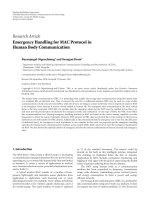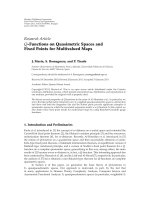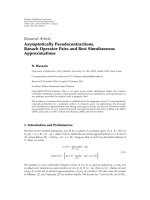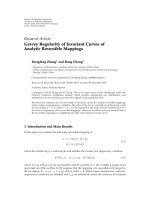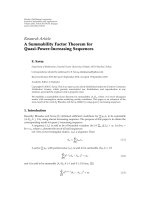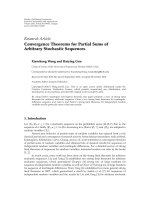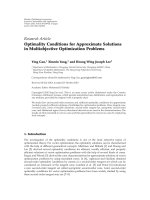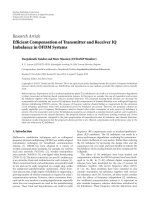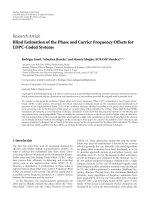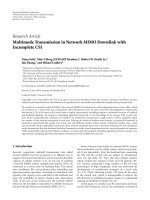Báo cáo hóa học: " Research Article Asymptotically Pseudocontractions, Banach Operator Pairs and Best Simultaneous Approximations" pdf
Bạn đang xem bản rút gọn của tài liệu. Xem và tải ngay bản đầy đủ của tài liệu tại đây (525.03 KB, 11 trang )
Hindawi Publishing Corporation
Fixed Point Theory and Applications
Volume 2011, Article ID 812813, 11 pages
doi:10.1155/2011/812813
Research Article
Asymptotically Pseudocontractions,
Banach Operator Pairs and Best Simultaneous
Approximations
N. Hussain
Department of Mathematics, King Abdulaziz University, P.O. Box 80203, Jeddah 21589, Saudi Arabia
Correspondence should be addressed to N. Hussain,
Received 3 December 2010; Accepted 12 January 2011
Academic Editor: Mohamed Amine Khamsi
Copyright q 2011 N. Hussain. This is an open access article distributed under the Creative
Commons Attribution License, which permits unrestricted use, distribution, and reproduction in
any medium, provided the original work is properly cited.
TheexistenceofcommonfixedpointsisestablishedforthemappingswhereT is asymptotically
f-pseudo-contraction on a nonempty subset of a Banach space. As applications, the invariant
best simultaneous approximation and strong convergence results are proved. Presented results
are generalizations of very recent fixed point and approximation theorems of Khan and Akbar
2009, Chen and Li 2007, Pathak and Hussain 2008, and several others.
1. Introduction and Preliminaries
We first review needed definitions. Let M be a subset of a normed space X, ·.Theset
P
M
u{x ∈ M : x − u distu, M} is called the set of best approximants to u ∈ X out of
M,wheredistu, Minf{y − u : y ∈ M}. Suppose that A and G are bounded subsets of
X. Then, we write
r
G
A
inf
g∈G
sup
a∈A
a − g,
cent
G
A
g
0
∈ G :sup
a∈A
a − g
0
r
G
A
.
1.1
The number r
G
A is called the Chebyshev radius of A w.r.t. G, and an element y
0
∈ cent
G
A
is called a best simultaneous approximation of A w.r.t. G.IfA {u},thenr
G
Adistu, G and
cent
G
A is the set of all best approximations, P
G
u,ofu from G. We also refer the reader
to Milman 1,andVijayraju2 for further details. We denote by
and clMw clM,
2 Fixed Point Theory and Applications
the set of positive integers and the closure weak closure of a set M in X, respectively. Let
f, T : M → M be mappings. The set of fixed points of T is denoted by FT.Apointx ∈ M
is a coincidence point common fixed point of f and T if fx Tx x fx Tx.Thepair
{f, T} is called
1 commuting 3 if Tfx fTx for all x ∈ M,
2 compatible see 3, 4 if lim
n
Tfx
n
− fTx
n
0 whenever {x
n
} is a sequence such
that lim
n
Tx
n
lim
n
fx
n
t for some t in M,
3 weakly compatible if they commute at their coincidence points; that is, if fTx Tfx
whenever fx Tx,
4 Banach operator pair,ifthesetFf is T-invariant, namely TFf ⊆ Ff.
Obviously, commuting pair T, f is a Banach operator pair but converse is not true
in general, see 5, 6.IfT, f is a Banach operator pair, then f, T need not be a
Banach operator pair see, e.g., 5, 7, 8.
The set M is called q-starshaped with q ∈ M,ifthesegmentq, x{1 − kq kx :0≤
k ≤
1} joining q to x is contained in M for all x ∈ M.Themapf defined on a q-starshaped
set M is called affine if
f
1 − k
q kx
1 − k
fq kfx, ∀x ∈ M. 1.2
Suppose that M is q-starshaped with q ∈ Ff and is both T-andf-invariant. Then, T and f
are called,
5 R-subweakly commuting on M see 9 if for all x ∈ M, there exists a real number
R>0suchthatfTx − Tfx≤R distfx,q, Tx
,
6 uniformly R-subweakly commuting on M \{q} see 10 if there exists a real number
R>0suchthatfT
n
x − T
n
fx≤R distfx,q, T
n
x,forallx ∈ M \{q} and n ∈ .
The map T : M → X is said to be demiclosed at 0 if, for every sequence {x
n
} in M
converging weakly to x and {Tx
n
} converges to 0 ∈ X,then0 Tx.
The classical Banach contraction principle has numerous generalizations, extensions
and applications. While considering Lipschitzian mappings, a natural question arises
whether it is possible to weaken contraction assumption a little bit in Banach contraction
principle and still obtain the existence of a fixed point. In this direction the work of Edelstein
11,Jungck3,Park12–18 and Suzuki 19 is worth to mention.
Schu 20 introduced the concept of asymptotically pseudocontraction and proved the
existence and convergence o f fixed points for this class of maps see also 21. Recently, Chen
and Li 5 introduced the class of Banach operator pairs, as a new class of noncommuting
maps and it has been further studied by Hussain 6,
´
Ciri
´
cetal.7, Khan and Akbar
22, 23 and Pathak and Hussain 8. More recently, Zhou 24 established a demiclosedness
principle for a uniformly L-Lipschitzian asymptotically pseudocontraction map and as an
application obtained a fixed point result for asymptotically pseudocontraction in the setup
of a Hilbert space. In this paper, we are able to join the concepts of uniformly f-Lipschitzian,
asymptotically f-pseudocontraction and Banach operator pair to get the result of Zhou 24 in
the setting of a Banach space. As a consequence, the common fixed point and approximation
results of Al-Thagafi 25, Beg et al. 10,Chidumeetal.26
, Chen and Li 5,Choetal.27,
Khan and Akbar 22, 23, Pathak and Hussain 8,Schu28 and Vijayraju 2 are extended
to the class of asymptotically f-pseudocontraction maps.
Fixed Point Theory and Applications 3
2. Main Results
Let X be a real Banach space and M be a subset of X.Letf, g T : M → M be mappings.
Then T is called
a an f, g-contraction if there exists 0 ≤ k<1suchthatTx − Ty≤kfx − gy for
any x, y ∈ M;ifk 1, then T is called f-nonexpansive,
b asymptotically f, g-nonexpansive 2 if there exists a sequence {k
n
} of real numbers
with k
n
≥ 1 and lim
n →∞
k
n
1suchthat
T
n
x − T
n
y
≤ k
n
fx − gy
2.1
for all x, y ∈ M and for each n ∈
;ifg id, then T is called f-asymptotically
nonexpansive map,
c pseudocontraction if and only if for each x, y ∈ M,thereexistsjx − y ∈ Jx − y
such that
Tx − Ty,j
x − y
≤
x − y
2
,
2.2
where J : X → 2
X
∗
is the normalized duality mapping defined by
J
u
j ∈ X
∗
:
u, j
u
2
,
j
u
; 2.3
d strongly pseudocontraction if and only if for each x, y ∈ M,thereexistsk ∈ 0, 1 and
jx − y ∈ Jx − y such that
Tx − Ty,j
x − y
≤ k
x − y
2
;
2.4
e asymptotically f, g-pseudocontractive if and only if for each n ∈
and x, y ∈ M,
there exists jx − y ∈ Jx − y and a constant k
n
≥ 1 with lim
n →∞
k
n
1suchthat
T
n
x − T
n
y, j
x − y
≤ k
n
fx − gy
2
.
2.5
If g id in 2.5,thenT is called asymptotically f-pseudocontractive 20, 24, 27,
f uniformly f, g-Lipschitzian if there exists some L>0suchthat
T
n
x − T
n
y
≤ L
fx − gy
, 2.6
for all x, y ∈ M and for each n ∈
;ifg id, then T is called uniformly f-Lipschitzian
20, 24, 29.
The map T is called uniformly asymptotically regular 2, 10 on M,ifforeachη>0, there
exists NηN such that T
n
x − T
n1
x <ηfor all n ≥ N and all x ∈ M.
4 Fixed Point Theory and Applications
The class of asymptotically pseudocontraction contains properly the class of asymp-
totically nonexpansive mappings and every asymptotically nonexpansive mapping is a
uniformly L-Lipschitzian 2, 24. For further details, we refer to 21, 24, 27, 29, 30.
In 1974, Deimling 30 proved the following fixed point theorem.
Theorem D. Let T be self-map of a closed convex subset K of a real Banach space X. Assume that T
is continuous strongly pseudocontractive mapping. Then, T has a unique fixed point.
The following result extends and improves Theorem 3.4 of Beg et al. 10,Theorem
2.10 in 22, Theorems 2.2 of 25 and Theorem 4 in 31.
Theorem 2.1. Let f, T be self-maps of a subset M of a real Banach space X. Assume that Ff
is closed (resp., weakly closed) and convex, T is uniformly f-Lipschitzian and asymptotically f-
pseudocontractive which is also uniformly asymptotically regular on M.IfclTM is compact
(resp., w clTM is weakly compact and id − T is demiclosed at 0) and T
Ff ⊆ Ff,then
FT ∩ Ff
/
∅.
Proof. For each n ≥ 1, define a self-map T
n
on Ff by
T
n
x
1 − μ
n
q μ
n
T
n
x, 2.7
where μ
n
λ
n
/k
n
and {λ
n
} is a sequence of numbers in 0, 1 such that lim
n →∞
λ
n
1
and q ∈ Ff.SinceT
n
Ff ⊂ Ff and Ff is convex with q ∈ Ff, it follows that T
n
maps Ff into Ff.AsFf is convex and cl TFf ⊆ Ffresp. w cl TFf ⊆ Ff,
so cl T
n
Ff ⊆ Ff resp. w cl T
n
Ff ⊆ Ff for each n ≥ 1. Since T
n
is a strongly
pseudocontractive on Ff,byTheoremD,foreachn ≥ 1, there exists x
n
∈ Ff such that
x
n
fx
n
T
n
x
n
.AsTFf is bounded, so x
n
− T
n
x
n
1 − μ
n
T
n
x
n
− q→0asn →∞.
Now,
x
n
− Tx
n
x
n
− T
n
x
n
T
n
x
n
− T
n1
x
n
T
n1
x
n
− Tx
n
≤
x
n
− T
n
x
n
T
n
x
n
− T
n1
x
n
L
fT
n
x
n
− fx
n
.
2.8
Since for each n ≥ 1, T
n
Ff ⊆ Ff and x
n
∈ Ff, therefore T
n
x
n
∈ Ff.ThusfT
n
x
n
T
n
x
n
.AlsoT is uniformly asymptotically regular, we have from 2.8
x
n
− Tx
n
≤
x
n
− T
n
x
n
T
n
x
n
− T
n1
x
n
L
T
n
x
n
− x
n
−→ 0, 2.9
as n →∞.Thusx
n
− Tx
n
→ 0asn →∞.AsclTM is compact, so there exists a
subsequence {Tx
m
} of {Tx
n
} such that Tx
m
→ z ∈ clTM as m →∞.Since{Tx
m
} is
asequenceinTFf and cl TFf ⊆ Ff, therefore z ∈ Ff.Moreover,
Tx
m
− Tz≤Lfx
m
− fz Lx
m
− z≤Lx
m
− Tx
m
LTx
m
− z. 2.10
Taking the limit as m →∞,wegetz Tz.Thus,M ∩ FT ∩ Ff
/
∅ proves the first case.
Fixed Point Theory and Applications 5
Since a weakly closed set is closed, by Theorem D, for each n ≥ 1, there exists x
n
∈
Ff such that x
n
fx
n
T
n
x
n
. The weak compactness of w clTM implies that there
is a subsequence {Tx
m
} of {Tx
n
} converging weakly to y ∈ w clTM as m →∞.Since
{Tx
m
} is a sequence in TFf and w cl TFf ⊆ Ff,soy ∈ Ff. Moreover, we have,
x
m
− Tx
m
→ 0asm →∞.Ifid− T is demiclosed at 0, then y Ty.Thus,M ∩ FT ∩ Ff
/
∅.
Remark 2.2. By comparing Theorem 3.4 of Beg et al. 10 with the first case of Theorem 2 .1,
their assumptions “M is closed and q-starshaped, fM M, TM \{q} ⊂ fM \{q},
f, T are continuous, f is linear, q ∈ Ff,clTM \{q} is compact, T is asymptotically
f-nonexpansive and T and f are uniformly R-subweakly commuting on M” are replaced
with “M is nonempty set, Ff is closed, convex, TFf ⊆ Ff,clTM is compact, T is
uniformly f-Lipschitzian and asymptotically f-pseudocontractive”.
If M is weakly closed and f is weakly continuous, then
Ff is weakly closed and
hence closed, thus we obtain the following.
Corollary 2.3. Let f, T be self-maps of a weakly closed subset M of a B anach space X. Assume that f
is weakly continuous, Ff is nonempty and convex, T is uniformly f-Lipschitzian and asymptotically
f-pseudocontractive which is also uniformly asymptotically regular on M.IfclTM is compact
(resp. w clTM is weakly compact and id − T is demiclosed at 0) and T, f is a Banach operator
pair, then FT ∩ Ff
/
∅.
A mapping f on M is called pointwise asymptotically nonexpansive 32, 33 if there exists
asequence{α
n
} of functions such that
f
n
x − f
n
y
≤ α
n
x
x − y
2.11
for all x, y ∈ M and for each n ∈
where α
n
→ 1 pointwise on M.
An asymptotically nonexpansive mapping is pointwise asymptotically nonexpansive.
A pointwise asymptotically nonexpansive map f defined on a closed bounded convex subset
of a uniformly convex Banach space has a fixed point and Ff is closed and convex 32, 33.
Thus we obtain the following.
Corollary 2.4. Let f be a pointwise asymptotically nonexpansive self-map of a closed bounded convex
subset M of a uniformly convex Banach space X. Assume that T is a self-map of M which is
uniformly f-Lipschitzian, asymptotically f-pseudocontractive and uniformly asymptotically regular.
If clTM is compact (resp. w clTM is weakly compact and id − T is demiclosed at 0) and
TFf ⊆ Ff,thenFT ∩ Ff
/
∅.
Corollary 2.5 see 24,Theorem3.3. Let T be self-map of a closed bounded and convex subset M of
a r eal Hilbert space X. Assume that
T is uniformly Lipschit zian and asymptotically pseudocontractive
which is also uniformly asymptotically regular on M.Then,FT
/
∅.
Corollary 2.6. Let X be a Banach space and T and f be self-maps of X.Ifu ∈ X, D ⊆ P
M
u,
D
0
: D ∩ Ff is closed (resp. weakly closed) and convex, clTD is compact (resp. w clTD is
weakly compact and id − T is demiclosed at 0), T is uniformly f-Lipschitzian and asymptotically
f-pseudocontractive which is also uniformly asymp totically regular on D,andTD
0
⊆ D
0
,
thenP
M
u ∩ FT ∩ Ff
/
∅.
6 Fixed Point Theory and Applications
Remark 2.7. Corollary 2.6 extends Theorems 4.1 and 4.2 of Chen and Li 5 to a more general
class of asymptotically f-pseudocontractions.
Theorem 2.1 can be extended to uniformly f, g-Lipschitzian and asymptotically
f, g-pseudocontractive map which extends Theorem 2.10 of 22 to asymptotically f, g-
pseudocontractions.
Theorem 2.8. Let f, g, T be self-maps of a subset M of a Banach space X. Assume that Ff∩Fg
is closed (resp. weakly closed) a nd convex, T is uniformly f, g-Lipschitzian and asymptotically
f, g-pseudocontractive which is also uniformly asymptotically regular on M.IfclTM is
compact (resp. w clTM is weakly compact and id − T is demiclosed at 0) and TFf ∩ Fg ⊆
Ff ∩ Fg,then
FT ∩ Ff ∩ Fg
/
∅.
Proof. For each n ≥ 1, define a self-map T
n
on Ff ∩ Fg by
T
n
x
1 − μ
n
q μ
n
T
n
x, 2.12
where μ
n
λ
n
/k
n
and {λ
n
} is a sequence of numbers in 0, 1 such that lim
n →∞
λ
n
1and
q ∈ Ff ∩ Fg.SinceT
n
Ff ∩ Fg ⊂ Ff ∩ Fg and Ff ∩ Fg is convex with q ∈
Ff ∩ Fg, it follows that T
n
maps Ff ∩ Fg into Ff ∩ Fg.AsFf∩ Fg is convex and
cl TFf∩Fg ⊆ Ff∩Fgresp. w cl TFf∩Fg ⊆ Ff∩Fg,soclT
n
Ff∩Fg ⊆
Ff ∩ Fg resp. w cl T
n
Ff ∩ Fg ⊆ Ff ∩ Fg for each n ≥ 1. Further, since T
n
is
a strongly pseudocontractive on Ff ∩ Fg,byTheoremD,foreachn ≥ 1, there exists
x
n
∈ Ff ∩ Fg such that x
n
fx
n
gx
n
T
n
x
n
. Rest of the proof is similar to that of
Theorem 2.1.
Corollary 2.9. Let f, g, T be self-maps of a subset M of a Banach space X. Assume that Ff∩Fg
is closed (resp. weakly closed) a nd convex, T is uniformly f, g-Lipschitzian and asymptotically
f, g-pseudocontractive which is also uniformly asymptotically regular on M.IfclTM is
compact (resp. w clTM is weakly compact and id − T is demiclosed at 0) and T, f and T, g are
Banach operator pairs, then FT ∩ Ff ∩ Fg
/
∅.
Corollary 2.10. Let X be a Banach space and T, f,andg be self-maps of X.Ify
1
,y
2
∈ X, D ⊆
cent
K
{y
1
,y
2
},wherecent
K
A is the set of best simultaneous approximations of A w.r.t K. Assume
that D
0
: D ∩ Ff ∩ Fg is closed (resp. weakly closed) and convex, clTD is compact (resp.
w clTD is weakly compact and id − T is demiclosed at 0), T is uniformly f, g-Lipschitzian and
asymptotically f, g-pseudocontractive which is also uniformly asymptotically regular on D,and
TD
0
⊆ D
0
,thencent
K
{y
1
,y
2
}∩FT ∩ Ff ∩ Fg
/
∅.
Remark 2.11. 1 Theorem 2.2 and 2.7 of Khan and Akbar 23 are particular cases of
Corollary 2.10.
2 By comparing Theorem 2.2 of Khan and Akbar 23 with the first case of
Corollary 2.10, their assumptions “cent
K
{y
1
,y
2
} is nonempty, compact, starshaped with
respect to an element q ∈ Ff ∩ Fg,cent
K
{y
1
,y
2
} is invariant under T, f and g, T, f
and T, g are Banach operator pairs on cent
K
{y
1
,y
2
}, Ff and Fg are q-starshaped with
q ∈ Ff ∩ Fg, f and g are continuous and T is asymptotically f, g-nonexpansive on
D,” are replaced with “D ⊆ cent
K
{y
1
,y
2
}, D
0
: D ∩ Ff ∩ Fg is closed and convex,
TD
0
⊆ D
0
,clTD is compact and T is uniformly f, g-Lipschitzian and asymptotically
f, g-pseudocontractive on D.”
Fixed Point Theory and Applications 7
3 By comparing Theorem 2.7 of Khan and Akbar 23 with the second case of
Corollary 2.10, their assumptions “cent
K
{y
1
,y
2
} is nonempty, weakly compact, starshaped
with respect to an element q ∈ Ff ∩ Fg,cent
K
{y
1
,y
2
} is invariant under T, f and g,
T, f and T, g are Banach operator pairs on cent
K
{y
1
,y
2
}, Ff and Fg are q-starshaped
with q ∈ Ff ∩ Fg, f and g are continuous under weak and strong topologies, f − T
is demiclosed at 0 and T is asymptotically f, g-nonexpansive on D,” are replaced with
“D ⊆ cent
K
{y
1
,y
2
}, D
0
: D ∩ Ff ∩ Fg is weakly closed and convex, TD
0
⊆ D
0
,
w clTD is weakly compact and id − T is demiclosed at 0 and T is uniformly f, g-
Lipschitzian and asymptotically f, g-pseudocontractive on D.”
We denote by
0
the class of closed convex subsets of X containing 0. For M ∈
0
,we
define M
u
{x ∈ M : x≤2u}. It is clear that P
M
u ⊂ M
u
∈
0
see 9, 25.
Theorem 2.12. Let f, g, T be self-maps of a Banach space X.Ifu ∈ X and M ∈
0
such that
TM
u
⊆ M, clTM
u
is compact (resp. w clTM
u
is weakly compact) and Tx− u≤x − u
for all x ∈ M
u
,thenP
M
u is nonempty, closed and convex with TP
M
u ⊆ P
M
u. If, in addition,
D ⊆ P
M
u, D
0
: D ∩ Ff ∩ Fg is closed (resp. weakly closed) and convex, clTD is compact
(resp. w clTD is weakly compact and id − T is demiclosed at 0), T is uniformly f, g-Lipschitzian
and asymptotically f, g-pseudocontractive which is also uniformly asym ptotically regular on D,and
TD
0
⊆ D
0
,thenP
M
u ∩ FT ∩ Ff ∩ Fg
/
∅.
Proof. We may assume that u/∈ M.Ifx ∈ M \ M
u
,thenx > 2u.Notethat
x − u
≥
x
−
u
>
u
≥ dist
u, M
. 2.13
Thus, distu, M
u
distu, M ≤u.IfclTM
u
is compact, then by the continuity
of norm, we get z − u distu, clTM
u
for some z ∈ clTM
u
.
If we assume that w clTM
u
is weakly compact, using Lemma 5.5 in 34, page 192,
we can show the existence of a z ∈ w clTM
u
such that distu, w clTM
u
z − u.
Thus,inbothcases,wehave
dist
u, M
u
≤ dist
u, cl T
M
u
≤ dist
u, T
M
u
≤
Tx − u
≤
x − u
, 2.14
for all x ∈ M
u
.Hencez− u distu, M and so P
M
u is nonempty, closed and convex with
TP
M
u ⊆ P
M
u.ThecompactnessofclTM
u
resp. weak compactness of w clTM
u
implies t hat clTD is compact resp. w clTD is weakly compact. The result now
follows from Theorem 2.8.
Remark 2.13. Theorem 2.12 extends Theorems 4.1 a nd 4.2 in 25,Theorem8in31,and
Theorem 2.15 in 22.
Definition 2.14 . Let M be a nonempty closed subset of a Banach space X, I, T : M → M be
mappings and C {x ∈ M : hxmin
z∈M
hz}.ThenI and T are said to satisfy property
S10, 27 if the following holds: for any bounded sequence {x
n
} in M, lim
n →∞
x
n
−Tx
n
0
implies C ∩ FI ∩ FT
/
∅.
The normal structure coefficient NX of a Banach space X is defined 10, 26
by NXinf{diamM/r
C
M : M is nonempty bounded convex subset of X with
8 Fixed Point Theory and Applications
diamM > 0},wherer
C
Minf
x∈M
{sup
y∈M
x − y} is the Chebyshev radius of M relative
to itself and diamMsup
x,y∈M
x − y is diameter of M.ThespaceX is said to have the
uniform normal structure if NX > 1. A Banach limit LIM is a bounded linear functional
on l
∞
such that lim inf
n →∞
t
n
≤ LIMt
n
≤ lim sup
n →∞
t
n
and LIMt
n
LIMt
n1
for all bounded
sequences {t
n
} in l
∞
.Let{x
n
} be bounded sequence in X. Then we can define the real-valued
continuous convex function f on X by fzLIMx
n
− z
2
for all z ∈ X.
The following lemmas are well known.
Lemma 2.15 see 10, 27. Let X be a Banach space with uniformly Gateaux differentiable norm
and u ∈ X.Let{x
n
} be bounded sequence in X.Thenfuinf
z∈X
fz if and only if LIMz, Jx
n
−
u 0 for all z ∈ X,whereJ : X → X
∗
is the normalized duality mapping and ·, · denotes the
generalized duality pairing.
Lemma 2.16 see 10, 26. Let M be a convex subset of a smooth Banach space X, D be a nonempty
subset of M and P be a retraction from M onto D.ThenP is sunny and nonexpansive if and only if
x − Px,Jz − Px≤0 for all x ∈ M and z ∈ D.
Now, we are ready to prove strong convergence to nearest common fixed points of
asymptotically f-pseudocontraction mappings.
Theorem 2.17. Let M be a subset of a reflexive real Banach space X with uniformly Gateaux
differentiable norm. Let f and T be self-maps on M such that Ff is closed and convex, T
is continuous, uniformly asymptotically regular, uniformly f-Lipschitzian and asymptotically f-
pseudocontractive with a sequence {k
n
}.Let{λ
n
} be sequence of real numbers in 0, 1 such t hat
lim
n →∞
λ
n
1 and lim
n →∞
k
n
− 1/k
n
− λ
n
0.IfTFf ⊂ Ff, then we have the following.
A For each n ≥ 1,thereisexactlyonex
n
in M such that
fx
n
x
n
1 − μ
n
q μ
n
T
n
x
n
2.15
B If {x
n
} is bounded and f and T satisfy property S,then{x
n
} converges strongly to
Pq ∈ FT ∩ Ff,whereP is the sunny nonexpansive retraction from M onto FT.
Proof. Part A follows from the proof of Theorem 2.1.
B As in Theorem 2.1, we get lim
n →∞
x
n
− Tx
n
0. Since {x
n
} is bounded, we can
define a function h : M → R
by hzLIMx
n
− z
2
for all z ∈ M.Sinceh is continuous
and convex, hz →∞as z→∞and X is reflexive, hz
0
min
z∈M
hz for some z
0
∈ M.
Clearly, the set C {x ∈ M : hxmin
z∈M
hz} is nonempty. Since {x
n
} is bounded and f
and T satisfy property S, it follows that C∩Ff∩FT
/
∅. Suppose that v ∈ C∩Ff∩FT,
then by Lemma 2.15,wehave
LIM
x − v, J
x
n
− v
≤ 0 ∀x ∈ M. 2.16
In particular, we have
LIM
q − v, J
x
n
− v
≤ 0. 2.17
Fixed Point Theory and Applications 9
From 2.8,wehave
x
n
− T
n
x
n
1 − μ
n
q − T
n
x
n
1 − μ
n
μ
n
q − x
n
.
2.18
Now, for any v ∈ C ∩ Ff ∩ FT,wehave
x
n
− T
n
x
n
,J
x
n
− v
x
n
− v T
n
v − T
n
x
n
,J
x
n
− v
≥−
k
n
− 1
x
n
− v
2
≥−
k
n
− 1
K
2
2.19
for some K>0. It follows from 2.18 that
x
n
− q, J
x
n
− v
≤
k
n
− 1
k
n
− λ
n
K
2
.
2.20
Hence we have
LIM
x
n
− q, J
x
n
− v
≤ 0. 2.21
This together with 2.17 implies that LIMx
n
− v, Jx
n
− v LIMx
n
− v
2
0.
Thus there is a subsequence {x
m
} of {x
n
} which converges strongly to v. Suppose that
there is another subsequence {x
j
} of {x
n
} which converges strongly to y say.SinceT is
continuous and lim
n →∞
x
n
− Tx
n
0, y is a fixed point of T. It follows from 2.21 that
v − q, J
v − y
≤ 0,
y − q, J
y − v
≤ 0. 2.22
Adding these two inequalities, we get
v − y,J
v − y
v − y
2
≤ 0andthusv y. 2.23
Consequently, {x
n
} converges strongly to v ∈ Ff ∩ FT.Wecandefinenowa
mapping P from M onto FT by lim
n →∞
x
n
Pq.From2.21,wehaveq−Pq,Jv−Pq≤0
for all q ∈ M and v ∈ FT.ThusbyLemma 2.16, P is the sunny nonexpansive retraction on
M.Noticethatx
n
fx
n
and lim
n →∞
x
n
Pq, so by the same argument as in the proof of
Theorem 2.1 we obtain, Pq ∈ Ff.
Remark 2.18. Theorem 2.17 extends Theorem 1 in 27. Notice that the conditions of the
continuity and linearity of f are not needed in Theorem 3.6 of Beg et al. 10;moreover,
we have obtained the conclusion for more general class of uniformly f-Lipschitzian and
asymptotically f-pseudocontractive map T without any type of commutativity of f and T.
10 Fixed Point Theory and Applications
Corollary 2.19 see 26,Theorem3.1. Let M be a closed convex bounded subset of a real Banach
space X with uniformly G
ˆ
ateaux differentiable norm possessing uniform normal structure. Let T :
M → M be an asymptotically nonexpansive mapping with a sequence {k
n
}.Letu ∈ M be fixed, {λ
n
}
be sequence of real numbers in 0, 1 such that lim
n →∞
λ
n
1 and lim
n →∞
k
n
− 1/k
n
− λ
n
0.
Then,
A for each n ≥ 1, there is unique x
n
in M such that
x
n
1 − μ
n
u μ
n
T
n
x
n
, 2.24
B if lim
n →∞
x
n
− Tx
n
0 ,then{x
n
} converges strongly to a fixed point of T.
Remark 2.20. 1 Theorem 2.17 improves and extends the results of Beg et al. 10,Choetal.
27, and Schu 20, 28 to more general class of Banach operators.
2 It would be interesting to prove similar results in Modular Function Spaces cf.
29.
3 Let X
with the usual norm and M 0, 1. A mapping T is defined by Tx
x,forx ∈ 0, 1/2 and Tx 0, for x ∈ 1/2, 1 and fxx on M. Clearly, T is not f-
nonexpansive 21e.g., T3/4 − T1/2 1/2andf3/4 − f1/2 1/4.But,T is a
f-pseudocontractive mapping.
References
1 P. D. Milman, “On best simultaneous approximation in normed linear spaces,” Journal o f
Approximation Theory, vol. 20, no. 2, pp. 223–238, 1977.
2 P. Vijayraju, “Applications of fixed point theorem to best simultaneous approximations,” Indian
Journal of P ure and Applied Mathematics, pp. 21–26, 1993.
3 G. Jungck, “Common fixed points for commuting and compatible maps on compacta,” Proceedings of
the American Mathematical Society, vol. 103, no. 3, pp. 977–983, 1988.
4 G. Jungck and N. Hussain, “Compatible maps and invariant approximations,” Journal of Mathematical
Analysis and Applications, vol. 325, no. 2, pp. 1003–1012, 2007.
5 J. Chen and Z. Li, “Common fixed-points for Banach operator pairs in best approximation,” Journal of
Mathematical Analysis and Applications, vol. 336, no. 2, pp. 1466–1475, 2007.
6 N. Hussain, “Common fixed points in best approximation for Banach operator pairs with
´
Ciri
´
ctype
I-contractions,” Journal of Mathematical Analysis and Applications, vol. 338, no. 2, pp. 1351–1363, 2008.
7 L.
´
Ciri
´
c, N. Hussain, F. Akbar, and J. S. Ume, “Common fixed points for Banach operator pairs from
the set of best approximations,” Bulletin of the Belgian Mathematical Society, vol. 16, no. 2, pp. 319–336,
2009.
8 H. K. Pathak and N. Hussain, “Common fixed points for Banach operator pairs with applications,”
Nonlinear Analysis: Theory, Methods & Applications, vol. 69, no. 9, pp. 2788–2802, 2008.
9 N. Hussain and G. Jungck, “Common fixed point and invariant approximation results for noncom-
muting generalizedf, g-nonexpansive maps,” Journal of Mathematical Analysis and Applications,vol.
321, no. 2, pp. 851–861, 2006.
10 I. Beg, D. R. Sahu, and S. D. Diwan, “Approximation of fixed points of uniformly R-subweakly
commuting mappings,” Journal of Mathematical Analysis and Applications, vol. 324, no. 2, pp. 1105–
1114, 2006.
11 M. Edelstein, “On fixed and periodic points under contractive mappings,” Journal of the London
Mathematical Society Second Series, vol. 37, pp. 74–79, 1962.
12 S. Park, “A generalization of a theorem of Janos and Edelstein,” Proceedings of the American
Mathematical Society, vol. 66, no. 2, pp. 344–346, 1977.
13 S. Park, “Fixed points of f-contractive maps,” The Rocky Mountain Journal of Mathematics,vol.8,no.4,
pp. 743–750, 1978.
Fixed Point Theory and Applications 11
14 S. Park, “On f-nonexpansive maps,” Journal of the Korean Mathematical Society, vol. 16, no. 1, pp. 29–38,
1979-1980.
15 S. Park, “On general contractive-type conditions,” Journal of the Korean Mathematical Society , vol. 17,
no. 1, pp. 131–140, 1980/81.
16 S. Park, “Some general theorems on common fixed points,” Kobe Journal of Mathematics,vol.4,no.2,
pp. 141–145, 1988.
17 S. Park, “Best approximations and fixed points of nonexpansive maps in Hilbert spaces,” Numerical
Functional Analysis and Optimization., vol. 18, no. 5-6, pp. 649–657, 1997.
18 S. Park, “A unified fixed point theory in generalized convex spaces,” Acta Mathematica Sinica, English
Series, vol. 23, no. 8, pp. 1509–1526, 2007.
19 T. Suzuki, “A generalized Banach contraction principle that characterizes metric completeness,”
Proceedings of the American Mathematical Society, vol. 136, no. 5, pp. 1861–1869, 2008.
20 J. Schu, “Iterative construction of fixed points of asymptotically nonexpansive mappings,” Journal of
Mathematical Analysis and Applications, vol. 158, no. 2, pp. 407–413, 1991.
21 Y. Song, “Iterative convergence to Ces
`
aro means for continuous pseudocontractive mappings,”
Nonlinear Analysis: Theory, Methods & Applications, vol. 71, no. 7-8, pp. 2792–2800, 2009.
22 A. R. Khan and F. Akbar, “Best simultaneous approximations, asymptotically nonexpansive
mappings and variational inequalities in Banach spaces,” Journal of Mathematical Analysis a nd
Applications, vol. 354, no. 2, pp. 469–477, 2009.
23 A. R. Khan and F. Akbar, “Common fixed points fr om best simultaneous approximations,” Taiwanese
Journal of Mathematics, vol. 13, no. 5, pp. 1379–1386, 2009.
24 H. Zhou, “Demiclosedness principle with applications for asymptotically pseudo-contractions in
Hilbert spaces,” Nonlinear Analysis: Theory, Methods & Applications, vol. 70, no. 9, pp. 3140–3145, 2009.
25 M. A. Al-Thagafi, “Common fixed points and best approximation,” Journal of Approximation Theory,
vol. 85, no. 3, pp. 318–323, 1996.
26 C. E. Chidume, J. Li, and A. Udomene, “Convergence of paths and approximation of fixed points
of asymptotically nonexpansive mappings,” Proceedings of the American Mathematical Society, vol. 133,
no. 2, pp. 473–480, 2005.
27 Y. J. Cho, D. R. Sahu, and J. S. Jung, “Approximation of fixed points of asymptotically
pseudocontractive mappings in Banach spaces,”
Southwest Journal of Pure and Applied Mathematics,
no. 2, pp. 49–59, 2003.
28 J. Schu, “Approximation of fixed points of asymptotically nonexpansive mappings,” Proceedings of the
American Mathematical Society, vol. 112, no. 1, pp. 143–151, 1991.
29 M. A. Khamsi and W. M. Kozlowski, “On asymptotic pointwise contractions in modular function
spaces,” Nonlinear Analysis: Theory, Methods & Applications, vol. 73, no. 9, pp. 2957–2967, 2010.
30 K. Deimling, “Zeros of accretive operators,” Manuscripta Mathematica, vol. 13, pp. 365–374, 1974.
31 L. Habiniak, “Fixed point theorems and invariant approximations,” Journal of Approximation Theory,
vol. 56, no. 3, pp. 241–244, 1989.
32 N. Hussain and M. A. Khamsi, “On asymptotic pointwise contractions in metric spaces,” Nonlinear
Analysis: Theory, Methods & Applications, vol. 71, no. 10, pp. 4423–4429, 2009.
33 W. A. Kirk and H K. Xu, “Asymptotic pointwise contractions,” Nonlinear A nalysis: Theory, Methods &
Applications, vol. 69, no. 12, pp. 4706–4712, 2008.
34 S. Singh, B. Watson, and P. Srivastava, Fixed Point Theory and Best Approximation: The KKM-Map
Principle, vol. 424 of Mathematics and Its Applications, Kluwer Academic Publishers, Dordrecht, The
Netherlands, 1997.
